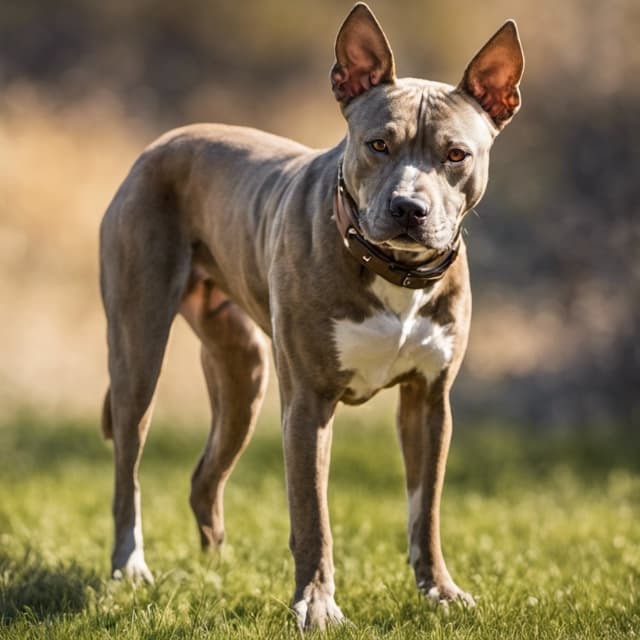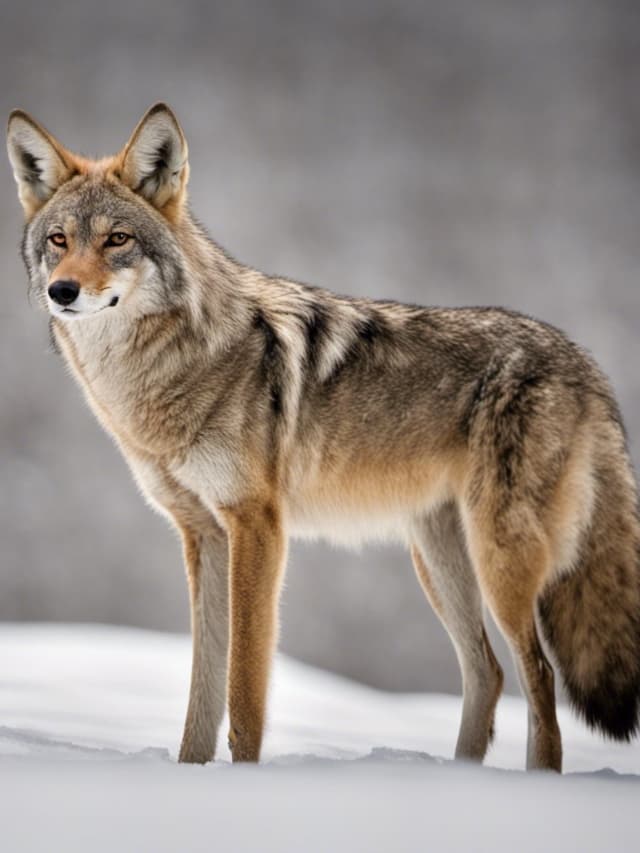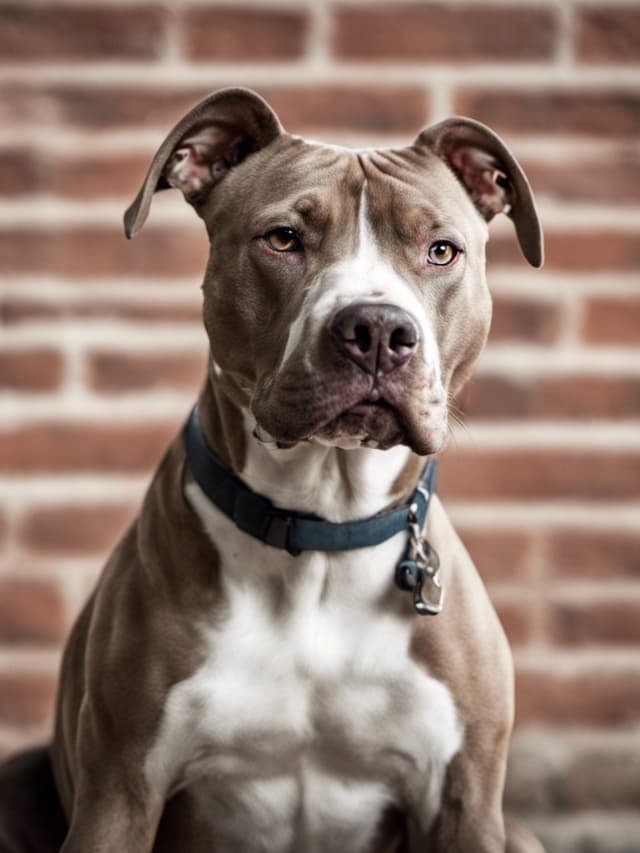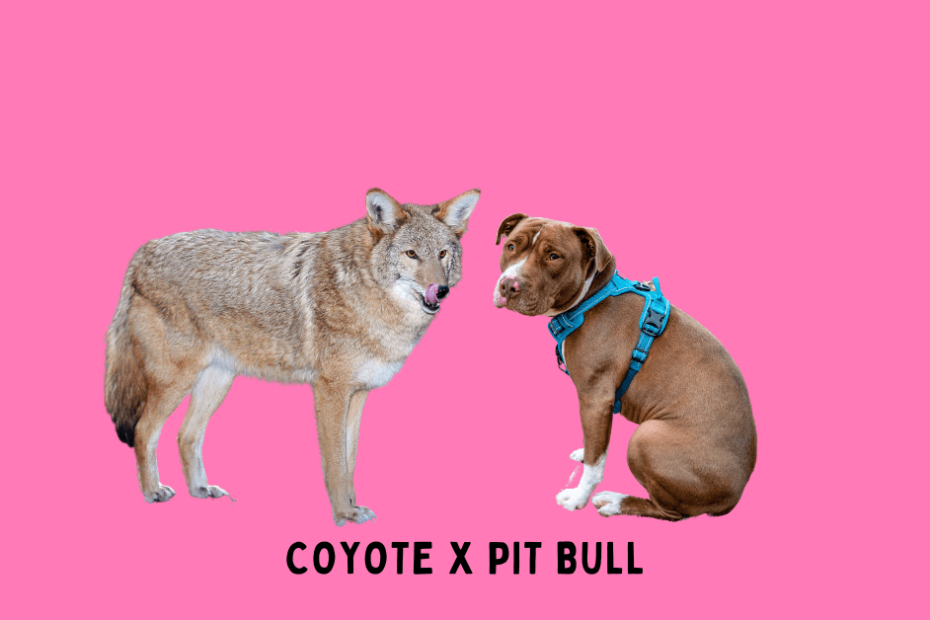A Coyote mixed with a Pit Bull? Yes, you heard it right.
In this article, I will explore this extremely unusual mix. Check it out!
Meet the Coyote-Pit Bull Mix
The Coyote-Pitbull mix combines the wild instincts of the Coyote with the strength and loyalty of the American Pit Bull Terrier. This unique hybrid is classified as a Coydog – half Coyote, half dog.

Coyotes are highly adaptable animals found across North America, known for their cunning, cleverness, and ability to thrive in various environments.
On the other hand, Pit Bulls are energetic and loving dogs, admired for their muscular physique and unwavering loyalty to their owners.
Despite their size difference, combining these two breeds creates a rare and curious mix.
A Coyote-Pitbull Mix typically exhibits a blend of physical traits from its Coyote and Pit Bull parents.
These mixed-breed pups can inherit a Coyote’s lean, agile body and a Pit Bull’s powerful muscles, resulting in an awe-inspiring appearance.
Their coat colors and patterns can also vary greatly, as Pit Bulls are known to come in a wide range of colors, while Coyotes are often shades of gray, tan, or brown.
The temperament of a Coyote-Pitbull Mix can be just as diverse as its appearance. While Pit Bulls are known for their loyalty, friendliness, and friendly personalities, Coyotes are naturally wild, cautious, and independent animals.
This crossbreed can exhibit a broad range of characteristics, from friendliness and playfulness to intelligence and wariness around strangers.
| Characteristic | Coyote-Pit Bull Mix |
|---|---|
| Size | Medium to Large (40-70 lbs, variable depending on parent sizes) |
| Lifespan | 10-15 years |
| Color | Variable (Grizzled, tan, black, brindle, white, etc.) |
| Coat Type | Short to Medium, possibly coarse |
| Temperament | Intelligent, Loyal, Independent, Protective, Variable |
| Exercise Needs | Moderate to High |
| Socialization Needs | High (Especially important due to wild ancestry) |
| Training Difficulty | Moderate (Smart but can be independent-minded) |
| Good with Kids? | Uncertain (Depends on socialization and individual temperament) |
| Good with Pets? | Uncertain (Depends on socialization and individual temperament) |
| Health Issues | Generally hardy, but may inherit some Pit Bull-related health issues |
| Living Environment | Fenced yard recommended, not suitable for apartment living |
| Legal Status | May be restricted or illegal in some jurisdictions |
Brief History of the Parent Breeds
Let’s look at the history of the Pit Bull and Coyote. This will give us a better understanding of the traits and characteristics of the Pit Bull-Coyote mix.
Coyote
The Coyote, also known as the prairie wolf or brush wolf, is a Canidae family member. Even though they are wild animals, they are in the same family as domestic dogs.
The history of the Coyote goes back thousands of years, with roots tracing to North America.

For a long time, Coyotes were primarily found in arid regions and prairies, especially in the American West.
However, as European settlers expanded and transformed the landscape, the Coyote adapted and expanded its territory.
Once limited to the western plains and deserts, the Coyote moved eastward during the 19th and 20th centuries, filling ecological gaps left by the declining wolf populations.
This expansion was aided by human activity, such as land clearing and the elimination of natural predators.
Over time, Coyotes successfully colonized nearly all of North America, from Alaska and Canada down to Central America, adapting to diverse environments, including forests, grasslands, and even urban areas.
Originating from the Aztec word “coyotl,” these canids can be found from Alaska to Central America, but they’re widespread on the Great Plains in the U.S.
Although they were once limited to regions up to the Appalachian Mountains, their range has expanded to cover nearly all of the United States and Canada.
The largest Coyotes are usually found in the northeastern U.S. and eastern Canada.
When it comes to hunting, Coyotes are incredibly skilled and primarily active at night. They can reach speeds of up to 40 miles per hour and possess keen senses to aid in locating their prey.
In open spaces, they rely on their excellent vision, but their strong sense of smell and hearing comes into play in denser environments.
Whether solo or in a group, Coyotes are formidable hunters, adapting to their environment and available food sources remarkably easily.
Pit Bull
The American Pit Bull Terrier, commonly called the Pit Bull, is an iconic breed known for its muscular build and fearless nature.

Initially bred for bull-baiting in the United Kingdom, the breed evolved significantly upon its arrival in the United States.
There, it took on roles ranging from farm dogs to companions, even gaining fame as a symbol of American resilience during World War I through figures like “Sergeant Stubby,” a decorated war dog.
Today, the Pit Bull is one of America’s most recognizable and controversial breeds.
Many people think they are aggressive dogs. But Pit Bulls are known for their loyalty, intelligence, and even temperament when properly trained and socialized.
They are solid and athletic. At home, Pit Bulls are known to be great with kids, often nicknamed “nanny dogs” for their protective and loving nature towards family members.
But, like any breed, they require proper training and socialization from a young age to ensure they develop into well-behaved and balanced adults.
Controversially, Pit Bulls have been subject to breed-specific legislation in various jurisdictions due to concerns about aggression.

Many argue that these laws are misguided and that dog aggression is more closely related to upbringing and training than to breed.
Despite their controversial reputation, adequately trained and socialized Pit Bulls are great pets that bring joy and companionship to countless homes.
Physical Appearance
As a mix of the Coyote and American Pit Bull Terrier, this hybrid showcases a blend of the physical traits of both parent breeds.
It’s hard to say what this mix will look like, but we can gather a general idea.
Size
A Coyote-Pit Bull mix would likely be a medium to large-sized animal, given the size ranges of both parent breeds.
This mix could stand anywhere from 20 to 25 inches at the shoulder and weigh between 25 and 70 pounds.
The animal’s size depends on which parent’s genes are more dominant and other factors like diet and overall health.
It would likely possess a muscular, athletic build, reflecting the Pit Bull’s muscular frame and the Coyote’s lean, agile physique.
Coyote
A typical Coyote stands about 24 inches at the shoulder and weighs between 20 and 50 pounds. They measure around 3 to 4 feet long, including a tail about a foot long.
Male Coyotes are slightly larger than their female counterpart.
Pit Bull
Pit Bulls are a medium-sized dog. They are a robust and agile breed, standing roughly 18 to 21 inches at the shoulder and weighing between 30 and 85 pounds.
Coat
The coat color of a Coyote-Pit Bull mix could be pretty varied, given the range of colors found in both parent breeds.
Coyotes generally have a grizzled gray coat, some with reddish or brown tones. On the other hand, Pit Bulls come in a wide array of colors, including black, white, brindle, fawn, blue, and many combinations.
The mix could inherit any color or blend, leading to a uniquely patterned coat.
It’s also possible for the hybrid to mix the Coyote’s grizzled gray and any of the Pit Bull colors, resulting in a truly distinct and exciting appearance.
As with size, the dominant genes will play a significant role in determining the coat color of the Coyote-Pit Bull mix.
Temperament
The Coyote-Pit Bull mix combines domestic dog characteristics and wild canid lineages.
These animals are generally thought to inherit the Pit Bull’s capacity for loyalty and sociability alongside the Coyote’s more territorial and independent traits.
While specific temperaments can vary widely—partly because of the rarity of this mix and the consequent lack of comprehensive studies—observed specimens have demonstrated a blend of affectionate and protective behaviors.
Training and socialization from a young age are crucial for the Coyote-Pit Bull mix, especially given the potential for a more assertive or territorial disposition from their Coyote parent.
These measures can assist in fostering a balanced temperament, which is particularly important if the animal interacts with other pets or humans.
Shyness or timidity may also manifest in some of these hybrids, especially in unfamiliar settings.
Early socialization can help mitigate this trait, aiding the animal in adapting to various environments.
The mix also potentially inherits the vigilance of a Coyote and the physical strength of a Pit Bull, making it keenly alert to its surroundings, although not necessarily aggressive.
This Coyote hybrid presents a complex interplay of domestic and wild traits, rendering it a subject of interest for those studying canine behavior and genetics.
Due to its rarity and the lack of empirical data, much of our understanding of this hybrid’s temperament is speculative, based on observed characteristics of its parent breeds.
Health Issues
Like any other canine breed, the Coyote-Pit Bull mix has specific health concerns to consider.
Potential health issues that may arise in this mix include:
- Hip dysplasia: A common concern among many dog breeds, hip dysplasia occurs when the hip joint doesn’t fit correctly into the hip socket. This condition can lead to discomfort, pain, and arthritis in severe cases.
- Elbow dysplasia: Similar to hip dysplasia, elbow dysplasia involves the abnormal development of the elbow joint, causing pain and limited mobility.
It’s worth noting that both hip and elbow dysplasia are partially genetic; thus, responsible breeding practices play a vital role in reducing these health issues in the offspring.
A few more genetic health problems specific to the Pit Bull parent are worth noting:
- Allergies: Prone to skin allergies, which can cause itching and discomfort.
- Hypothyroidism is a condition where the thyroid gland doesn’t produce enough hormones, leading to lethargy and weight gain.
- Heart Disease: Some Pit Bulls are susceptible to various forms of heart disease, such as valve malformations or cardiomyopathy.
- Cataracts: An eye condition that can lead to impaired vision or blindness.
- Demodectic Mange: A skin condition caused by mites, leading to hair loss and skin infections.
- Progressive Retinal Atrophy (PRA): A genetic condition that affects the eyes and can lead to blindness.
- Obesity: Pit Bulls love to eat and can become overweight without proper exercise and diet.
- Osteosarcoma is a type of bone cancer that is more common in larger breeds.
- Deafness: Congenital or age-related hearing loss is occasionally observed in Pit Bulls.
Regular veterinary check-ups and a balanced lifestyle can help manage or prevent many of these conditions.
Lifespan
The expected lifespan for a Coyote-Pit Bull mix is between 10-15 years.
The average American Pit Bull Terrier can live up to 10-15 years, and Coyotes in the wild are known to survive for about 10 years. Given their mixed lineage, a Coyote-Pit Bull mix’s lifespan could be within that frame.
Prey Drive
As a carnivorous canine, the Coyote has an innate inclination to find, pursue, and capture prey. The Pit Bull, a highly trainable and powerful dog breed, also possesses a strong prey drive.
This combination results in the Coyote-Pit Bull mix having an even more intense desire for hunting.
With such a strong prey drive, this mix is highly energetic and will constantly look for potential prey, whether a small animal in the wild or an object in play.
Their keen senses of sight, smell, and hearing make them highly efficient in tracking and locating their target.
Considering that this potent mix of instincts can pose certain risks is essential. For example, their heightened aggression could lead them to target domestic animals or small pets if not appropriately supervised.
Therefore, early training and proper socialization are essential for this breed to help them understand boundaries and control their impulses.
Training
Training a Coyote-Pit Bull mix may be more complicated than training a purebred dog. The wild instincts of the Coyote may resist a proper training regimen.
However, training a Coydog is doable. It will require more patience.
First things first, start with socialization. As puppies, these playful mixes need exposure to various environments, people, and pets.
This helps them adapt to new situations and prevents anxiety or aggressive behavior as they grow.
Remember to show them lots of love and encouragement during this crucial process!
Obedience training is vital in teaching your mix of manners and respect. Start with basic commands such as “sit,” “stay,” and “come,” gradually progressing to more advanced ones. Your little mix will be eager to show off their new tricks in no time!
Here’s a quick overview of some training tips:
- Use positive reinforcement: Reward your mix with treats, praise, and affection for a job well done. This motivates them to continue learning and strengthens the bond between you two.
- Be consistent: Dogs thrive with routine and clear expectations. Establish rules and stick to them, such as no jumping on furniture or chewing on shoes. Consistency is key!
- Practice patience: Some days, training might be challenging, but remember that your Coyote-Pit Bull mix is learning, too. Stay calm and relaxed, and they will follow your lead.
- Keep sessions short: Dogs have short attention spans. Aim for 10-15 minute training sessions multiple times a day. This will keep your mix engaged and prevent them from becoming bored or overwhelmed.
- Always end on a positive note: Celebrate successes, even small ones. This will leave your mix excited for the next session.
Take advantage of the enthusiasm of the Coyote-Pit Bull mix by teaching them fun tricks.
Remember, training your mix is not only about teaching them to obey commands and learning new tricks. It’s also about ensuring they have a healthy, happy, and exciting life full of adventures.
Dietary Needs
A balance of high-quality proteins, vitamins, minerals, and healthy fats is essential to cater to their dietary needs.
As descendants of the Coyote and the American Pit Bull Terrier, these incredible animals inherit their food preferences from their ancestors.
As part of their ancestral diet, raw meat plays a crucial role in meeting the nutritional requirements of the Coyote-Pit Bull mix.
High-quality protein sources, such as chicken, beef, and salmon, are excellent choices for maintaining the breed’s muscle strength and energy levels.
Mixing in some organ meats, such as liver or kidney, is also a good idea for additional nutrition.
A well-planned diet includes more than just raw meat. Adding fresh fruits and vegetables to their meals boosts the overall nutritional content, providing essential vitamins and minerals needed for optimal health.
Some great choices include:
- Apples
- Carrots
- Blueberries
- Sweet potatoes
- Green beans
Remember always to serve these items in moderation, as overfeeding can lead to obesity and other health issues. A precise balance of nutrients is crucial for the well-being of the Coyote-Pit Bull mix.
Care and Grooming
Grooming is essential for the Coyote-Pit Bull mix, as they likely have a waterproof topcoat and a thick undercoat.
To keep their coat healthy and tangle-free, regular brushing is a must. Brushing the coat at least two to three times per week is recommended, but you might want to increase the frequency during shedding seasons.
These energetic hybrids crave daily exercise to expend their enthusiasm. A good mix of physical activities, such as walks, hikes, and games of fetch, will help keep them happy and fit.
Adequate exercise prevents boredom and reduces the likelihood of destructive behaviors.
In addition to physical exercise, your Coyote-Pit Bull mix will thrive on mental stimulation.
They’re intelligent dogs who enjoy learning new tricks and engaging in interactive play. Puzzle toys or training sessions can provide a fun challenge that keeps them mentally sharp.
Don’t forget to provide your Coyote-Pit Bull mix with plenty of fresh water and a comfortable area to rest after all that activity. Clean, fresh water is crucial to maintain their overall health, so ensure they can access it at all times.
Lastly, regular veterinary check-ups, vaccinations, and preventative care measures like heartworm and flea prevention are essential for keeping your Coyote-Pit Bull mix healthy.
Do they get along with children?
As family pets, they have the potential to fit in well with households that have children. However, it’s important to address specific factors to ensure a harmonious relationship between these mixed breeds and the little ones in the family.
The Coyote-Pit Bull mix has the strength and agility of a Coyote, combined with the loyalty and protectiveness of a Pit Bull.
This makes them a lively and energetic companion for children. Kids will undoubtedly enjoy this mixed breed’s playfulness and form cherished bonds.
That being said, it’s essential to establish proper boundaries between the mix and younger children.
Due to their innate enthusiasm, unintentional rough play may occur.
Parents should closely monitor interactions, especially during the initial adjustment period. As the mix and children grow more comfortable with each other, their relationship will likely flourish with proper guidance.
Do they get along with other pets?
The Coyote-Pit Bull mix can be a surprisingly pleasant and adaptable playmate.
Early socialization and exposure to multiple animals can significantly enhance their ability to bond and live peacefully with various creatures in your household.
It’s essential to remember that they’re not immune to their genetic instincts. Coyotes are natural predators, and when mixed with a Pit Bull, there may be an innate tendency to chase smaller animals.
Proper supervision and training are crucial in managing these powerful animals to ensure the safety of pets and other creatures in the vicinity.
Related Posts
- Did you know Pit Bulls can have fluffy coats? Check out the Fluffy Pit Bull.


